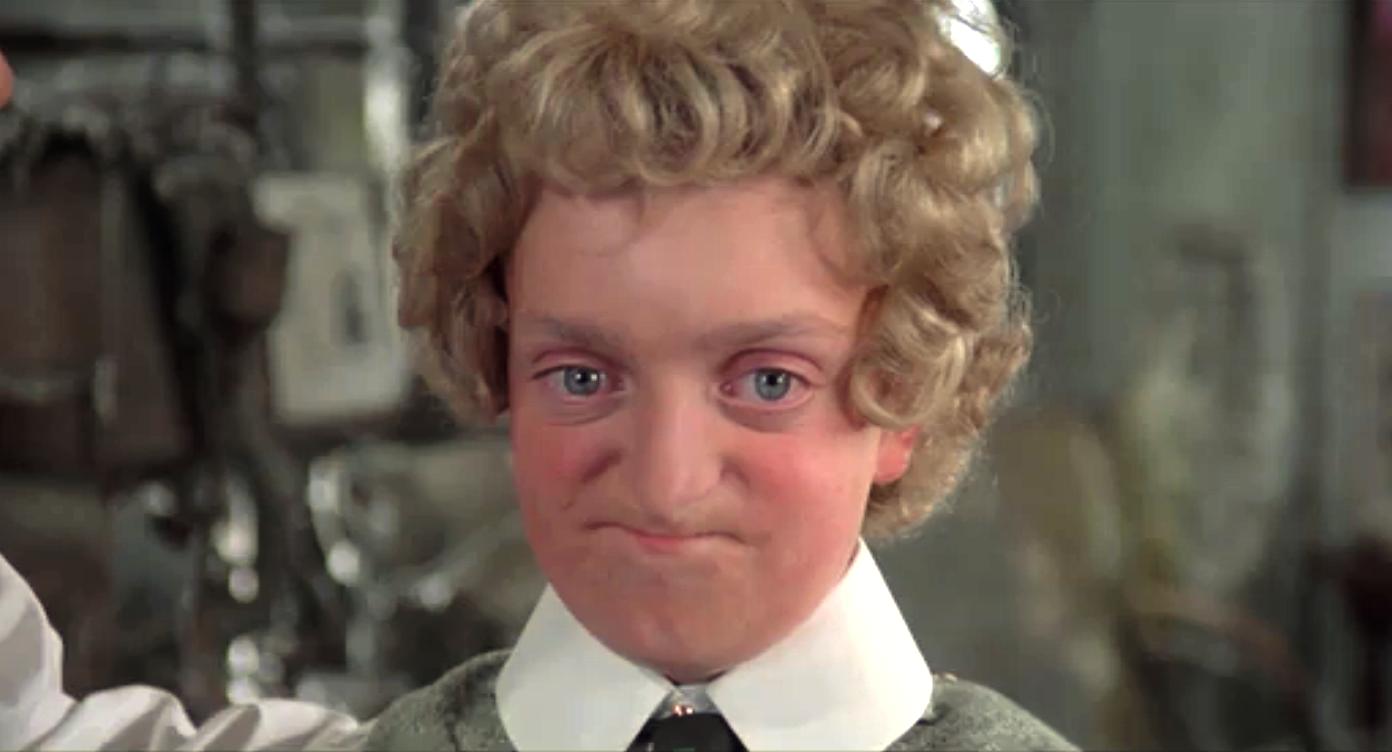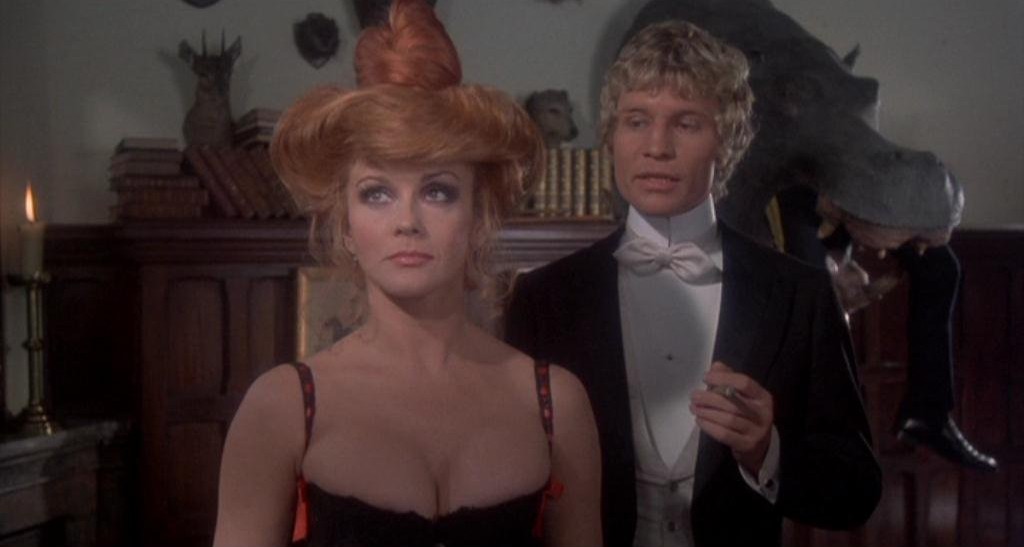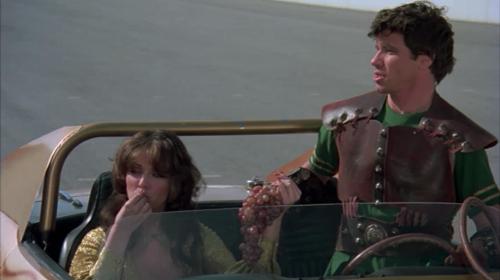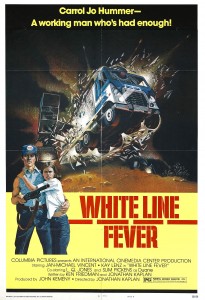
Last year’s tribute to Marty Feldman, covering three of my favorite performances, proved to be our most popular post to date here at WeirdFlix. This year, I thought we’d break new ground and examine a Feldman film I hadn’t yet seen. The Last Remake of Beau Geste (1977) was written and directed by Feldman with perennial musketeer Michael York in the title role and Feldman as his “identical” twin brother, Digby Geste.
The title references the many adaptations of P. C. Wren’s adventure novel Beau Geste, first published in 1924. There are three earnest adaptations and one BBC serial, each with its own variation on Beau’s exploits in the French Foreign Legion. Last Remake joins such comedy luminaries as Laurel and Hardy’s Beau Hunks (1931) and the Carry On film Follow that Camel (1967) in spoofing the tale of derring-do.
The Last Remake of Beau Geste (1977)
Marty Feldman made his feature film directorial debut with The Last Remake of Beau Geste, after directing an episode of the Mel Brooks Robin Hood parody When Things Were Rotten (1975) for the ABC Network. By the late 1970s, Marty was already a veteran of Mel Brooks/Gene Wilder farces, having appeared in Young Frankenstein (1974), The Adventure of Sherlock Holmes’ Smarter Brother (1975), and Silent Movie (1976). All three were very successful, especially given their modest budgets.
As The Last Remake opens, it becomes apparent that Marty Feldman was a great influence on his former collaborators Graham Chapman and John Cleese of Monty Python fame. Feldman indulges in not only parodying the adventure genre, but in deconstructing the tropes of film itself. Quite literally, in the case of the opening credits. This is perhaps zanier than even Mel Brooks’ fans are accustomed to, if one is not familiar with the Python style.
“The place: North Africa. The year: 1906.”
A rather amusing opening song explains the mercenary nature of the French Foreign Legion to the uninitiated. But first, we must backtrack some years to Merry Olde England and stately Geste Manor. Sir Hector Geste (Trevor Howard) eagerly awaits the birth of his son Beau, having already named him and proclaimed him an epic hero. When the child born proves to be a daughter, the enraged Sir Hector is forced to seek out the offerings at Wormwood & Gall Boys Orphanage.
Sir Hector has very specific requirements. “He’s got to be tall, blonde, and, per my specifications, he must have an aristocratic bearing and the necessary blue eyes. A lad to whom I can confidently bequeath my own noble features. I shall eventually need him to reach a height of six-feet-one and, naturally, he will be brought up with an English gentleman’s attitude and love of slaughter. That seems to cover the essentials.” He soon spies a curly, towheaded boy laying into the other ruffians with not a speck of dirt upon him. Young Obadiah Spittle is immediately rechristened Beau Geste.
Miss Wormwood protests, however. For a mere twelve guineas, she’ll throw in his identical twin brother, Digby. Sir Hector, envisioning two epic heroes, agrees sight unseen. Where they got a child version of Marty Feldman, I’ll never know, but it works.
The idyllic childhood of Beau, Digby, and Isabel Geste is disrupted when Sir Hector is called off to war. Before he can leave on his grand escapade, he shows Beau the Geste family treasure, the legendary Blue Water Sapphire, a gem of such beauty, the Hope Diamond and the Koh-i-Noor pale in comparison. Sir Hector puts it in rather cruder terms, but I’ll take the high road here.
While Sir Hector is off to war, the Geste children grow to young adulthood. Digby is now played by Marty Feldman while Michael York takes the title role of Beau. York was no stranger to swashbuckling, having previously appeared in Director Franco Zeffirelli’s Shakespeare adaptations, The Taming of the Shrew (1967) and Romeo and Juliet (1968). In the latter, he played the flamboyant swordsman Tybalt. It isn’t much of a stretch from the “Prince of Cats” to the role York is most often associated with, that of D’Artagnan in The Three Musketeers (1973) and The Four Musketeers (1974).
“And what of the lovely Isabel? She practiced and practiced and became an accomplished… virgin.” Primarily a television actress, Sinéad Cusack takes on the role of the adult Isabel. She had debuted with an uncredited role in Rocket to the Moon (1967) with Terry-Thomas (Geste‘s Governor), then appeared with Michael York in the costume drama Alfred the Great (1969). She performed alongside her father, respected Irish actor and “The Man Who Would Be Who”, Cyril Cusack, in Roddy McDowell’s The Ballad of Tam Lin (1970) for AIP.
Sir Hector returns from the Sudan with a chest full of medals and a trophy wife, Flavia (played by the voluptuous Ann-Margret). It may seem hard to believe in retrospect, but Ann-Margret had been nominated for a Best Supporting Actress Oscar for Carnal Knowledge (1971), then nominated for a Best Actress Oscar for Tommy (1975). She was perhaps born to play “Lady Booby” in Tony Richardson’s adaptation of the costume comedy Joseph Andrews (1977), and, though Geste was released just a few months later, it feels like she just reprises the role of the lusty widow.
Indeed, Flavia proves “too much for a man of his age,” and Sir Hector suffers a heart attack while in the throes of passion with his new bride. “He overcame himself.” Flavia gets an early start on grieving and arranges a nunnery for both Isabel and Digby, while she has other plans for handsome young Beau.
When she openly plans to sell the Blue Water to gentlemen from Cartier’s, the lights go out and the sapphire disappears. This plays out in an extended sequence that overstays its welcome but finishes strong for fans of Ann-Margret. A subsequent letter from Beau reveals that he has left for North Africa with the family treasure to keep it out of the hands of his wicked stepmother.
Digby keeps Beau’s secret and takes the rap for the theft. He is sentenced to hard labor, “956 years or life… whichever is the longer.”
When we catch up to Beau, he is “somewhere in Morocco…”
The new recruits to the French Foreign Legion are ready for inspection by Sergeant Markov (a bombastic Peter Ustinov). The veteran actor previously teamed with Michael York in Logan’s Run (1976) and played a charlatan in the Disney adventure Treasure of Matecumbe (1976), the first feature-length movie filmed on Disney’s Florida property. He will teach his little “fledermauses” how to die with dignity in the French fashion.
Meanwhile, Flavia visits Digby in prison and tries to get him to tell her where Beau has taken the Blue Water Sapphire. Digby rather vocally refuses to speak, forcing Flavia into the bed of the Governor (Terry-Thomas). There, she convinces him to arrange Digby’s “escape”, figuring he will lead her right to Beau. “It’s been a business doing pleasure with you,” she says with a wicked smile.
Here, the film takes a cinematic detour, paying homage to the 1926 silent film adaptation of Beau Geste, starring Ronald Colman. Soon, despite his inept efforts, Digby is free and reunited with his twin in Morocco. While they think they’ve seen the last of mother, Flavia is in hot pursuit and making good time with the delightfully foppish General Pecheur (Henry Gibson).
Gibson was already a veteran TV actor before Geste. He voiced the beloved pig Wilbur in Charlotte’s Web (1973). He also appeared in Director Robert Altman’s The Long Goodbye (1973) and Nashville (1975), getting a Golden Globe nomination for Best Supporting Actor in the latter.
Pecheur introduces Flavia to Sergeant Markov. For 200 francs, Flavia hires Markov to retrieve the gem from Beau, using whatever means necessary, and deliver it to her at their next destination, Fort Zindeneuf. Markov’s assistant, Boldini (Roy Kinnear) lays the groundwork for betrayal by revealing that the paste gem she seeks is no mere trinket, but the fabled Blue Water Sapphire.
En route to Fort Zindeneuf, the Legionnaires are assaulted by Arabs, and the Geste Boys get an opportunity to test their mettle. Inexplicably, a brown-faced Ed McMahon shows up to give us the score and take us out to a commercial break. Avery Schreiber does double duty as an Arab raider and as Honest Hakkim, a used camel salesman. When we return to the action, the Brothers Geste save the regiment banner and the dignity of the Legion.
When the march resumes, Digby finds himself separated from the unit and wandering into a “Mirage Area”. Here, we have another cinematic detour as Marty “Gumps” himself into footage from the 1939 Paramount adaptation of Beau Geste with Gary Cooper. If this scene is to be believed, Cooper’s trademark lackadaisical speech pattern is the result of “Moroccan Gold” cigarettes. Sounds canonical to me.
While Digby negotiates exit from the earlier film and the “Mirage Area”, we catch up with the Sheikh, leader of the Arabs. He enters a tent, and suprise # 1 is that he’s there to meet General Pecheur and Flavia Geste. Surprise # 2 is that when he unwraps his keffiyeh, we see he is none other than James Earl Jones. Surprise # 3 is that he’s a very proper British gentleman, not at all the desert savage we would expect.
Star Wars (1977) was released just two months prior to Geste, but Jones would not be widely associated with the Darth Vader role for some time, primarily because his voiceover work was uncredited at his own request. He starred in Swashbuckler (1976) with comedian Avery Schreiber, who plays his Sheikh’s Aide here.
The subsequent scene reveals a sadly underdeveloped plot twist, the fact that Pecheur is actually financing both sides of the conflict and expects better results from his Arab ally. He demands an attack on Fort Zindeneuf in which everyone is killed.
At Fort Zindeneuf, a regimental ball is held to celebrate the Legion’s victory. Attempts by Boldini to locate the Blue Water Sapphire, vulgar though they may be, prove fruitless. Empty-handed, Markov deftly avoids Flavia, leaving her to dance with her stepson Beau.
General Pecheur exits the ball early, aware that the Arabs are soon to beseige the fort. As they ride by, we find Flavia and Beau in the midst of a moonlit rendezvous. She lets slip some pillow talk that she doesn’t want to go back to the fort since it will be attacked at dawn. This restirs Beau’s passions, and they arrive on horseback in the midst of the Arab charge.
Beau reveals that the Legionnaires have been supplied with blank ammunition. The men voice their support for Beau Geste and offer to “die to the last man” behind him, but the supposed epic hero is aghast. “No, you can be free! So, for your own sakes, desert! Get out of here! Go and be rotten to people, but do it for a decent living wage!”
Digby and the Sheikh seem to be the only ones horrified by this turn of events. “How can I lead you if you won’t wait for me?!” The Sheikh rides off into the sunset with Rudolph Valentino (Martin Snaric), off to Hollywood and silent film. This leaves Markov and Beau to duel over the Blue Water and a pugilistically adept Flavia to save Digby from Boldini.
Beau honors what seems to be Markov’s last request, to reveal the hidden location of the Blue Water. He takes a saber to Markov’s wooden leg and the sapphire tumbles free from the hollow inner compartment. Markov and Boldini flee with “the Geste family fortune”, but Beau confesses it’s a fake. The real Blue Water has been in a safety deposit box in Paris the whole time.
As the last man alive in Fort Zindeneuf, Digby is hailed as a hero and reunites with Isabel at Geste Manor while Beau and Flavia retire to a posh beach resort.
FIN.
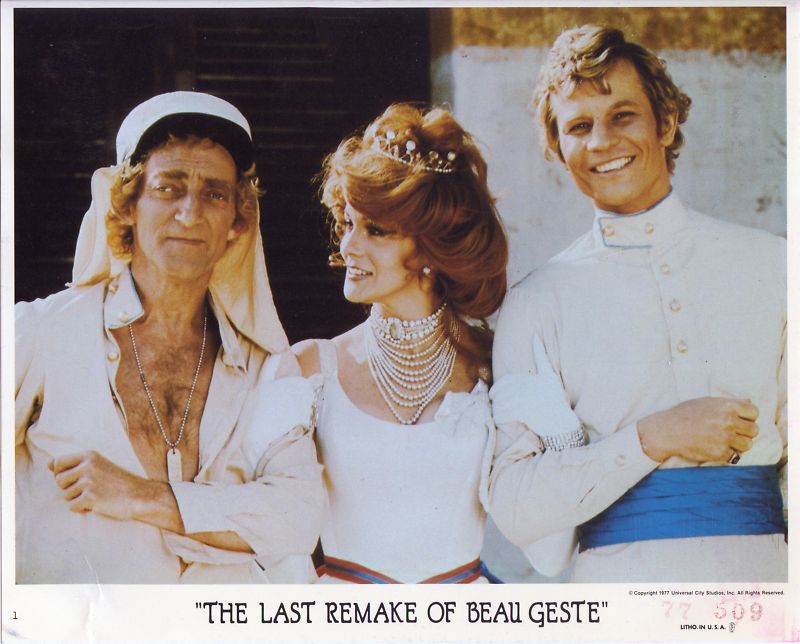
Marty Feldman, Ann-Margret, and Michael York in a
promotional photo for The Last Remake of Beau Geste (1977)
As is common with these sorts of spoofs, The Last Remake of Beau Geste is wildly uneven, but still quite amusing. Re-cut by Universal while Marty was touring Europe to promote the film, his version never made it to theaters. Though performing well in test screenings, Universal sticked to their guns and, sadly, it remains unavailable.
In Blazing Saddles (1974) and Young Frankenstein (1974), Mel Brooks managed to make decent, if light-hearted, examples of the genres he parodied, filled with endearing characters. Broader spoofs such as Monty Python and the Holy Grail (1975) and Airplane! (1980) filled the running time with non sequitur gags to account for their large ensemble casts of largely undeveloped characters. Sadly, the extant cut of Geste fails to achieve either effect, but it still contains enough laughs to be worth watching on a lazy Sunday afternoon.
Though it may not be the film he intended to release, it was great to spend time with the late, great Marty Feldman once again. We’ll be sure to do it again some time.
Now, I just have to find the supposedly serious 1966 adaptation of Beau Geste starring Doug McClure, Leslie Nielsen, and Telly Savalas. That’s sure to be a hoot.


